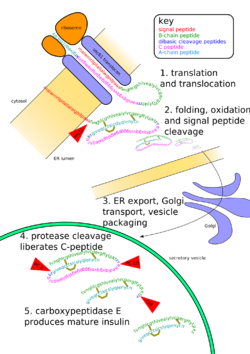
Preproinsulin
Encyclopedia

Translation
Translation is the communication of the meaning of a source-language text by means of an equivalent target-language text. Whereas interpreting undoubtedly antedates writing, translation began only after the appearance of written literature; there exist partial translations of the Sumerian Epic of...
product of the insulin
Insulin
Insulin is a hormone central to regulating carbohydrate and fat metabolism in the body. Insulin causes cells in the liver, muscle, and fat tissue to take up glucose from the blood, storing it as glycogen in the liver and muscle....
gene
Gene
A gene is a molecular unit of heredity of a living organism. It is a name given to some stretches of DNA and RNA that code for a type of protein or for an RNA chain that has a function in the organism. Living beings depend on genes, as they specify all proteins and functional RNA chains...
. It is a peptide
Peptide
Peptides are short polymers of amino acid monomers linked by peptide bonds. They are distinguished from proteins on the basis of size, typically containing less than 50 monomer units. The shortest peptides are dipeptides, consisting of two amino acids joined by a single peptide bond...
of 110 amino acid
Amino acid
Amino acids are molecules containing an amine group, a carboxylic acid group and a side-chain that varies between different amino acids. The key elements of an amino acid are carbon, hydrogen, oxygen, and nitrogen...
s. Preproinsulin is a precursor processed by proteases to proinsulin
Proinsulin
Proinsulin is the prohormone precursor to insulin made in the beta cells of the islets of Langerhans, specialized regions of the pancreas. In humans, proinsulin is encoded by the INS gene.- Synthesis and post-translational modification :...
by removal of the signal peptide and then to insulin
Insulin
Insulin is a hormone central to regulating carbohydrate and fat metabolism in the body. Insulin causes cells in the liver, muscle, and fat tissue to take up glucose from the blood, storing it as glycogen in the liver and muscle....
by removal of the connecting peptide (C-peptide
C-peptide
C-peptide is a protein that is produced in the body along with insulin. First preproinsulin is secreted with an A-chain, C-peptide, a B-chain, and a signal sequence. The signal sequence is cut off, leaving proinsulin...
) in order to be biologically active.
Almost no preproinsulin exists in the cell, since removal of the signal peptide is not a separate step but closely linked to translation into the endoplasmic reticulum
Endoplasmic reticulum
The endoplasmic reticulum is an organelle of cells in eukaryotic organisms that forms an interconnected network of tubules, vesicles, and cisternae...
(ER). For the same reason, preproinsulin is rarely used unlike insulin, the mature product, and proinsulin, a stable ER intermediate.
See also
- InsulinInsulinInsulin is a hormone central to regulating carbohydrate and fat metabolism in the body. Insulin causes cells in the liver, muscle, and fat tissue to take up glucose from the blood, storing it as glycogen in the liver and muscle....
- Signal peptideSignal peptideA signal peptide is a short peptide chain that directs the transport of a protein.Signal peptides may also be called targeting signals, signal sequences, transit peptides, or localization signals....
, signal peptide peptidaseSignal Peptide PeptidaseThe Signal Peptide Peptidase is an intramembrane aspartyl protease with the conserved active site motifs 'YD' and 'GxGD' in in adjacent transmembrane domains . Its sequences is highly conserved in different vertebrate species... - ProinsulinProinsulinProinsulin is the prohormone precursor to insulin made in the beta cells of the islets of Langerhans, specialized regions of the pancreas. In humans, proinsulin is encoded by the INS gene.- Synthesis and post-translational modification :...
- Proprotein convertase 1Proprotein convertase 1Proprotein convertase 1, also known as prohormone convertase, prohormone convertase 3, or neuroendocrine convertase 1 and often abbreviated as PC1/3 is an enzyme that in humans is encoded by the PCSK1 gene...
, proprotein convertase 2Proprotein convertase 2Proprotein convertase 2 also known as prohormone convertase 2 or neuroendocrine convertase 2 is a serine protease and proprotein convertase PC2, like proprotein convertase 1 , is an enzyme responsible for the first step in the maturation of many neuroendocrine peptides from their precursors, such...
External links
- preproinsulin definition in the glossary of the Beta Cell Biology Consortium

